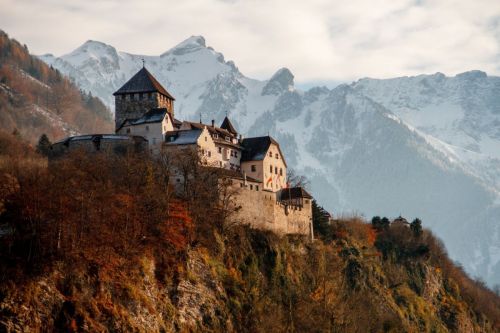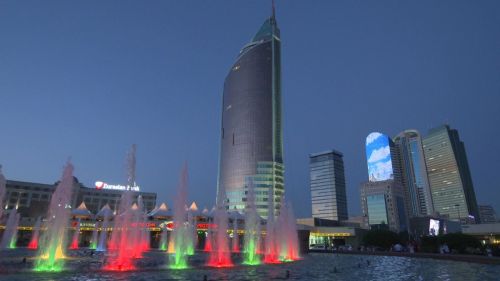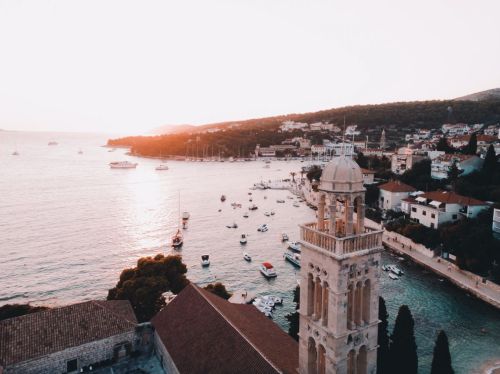Ireland is a Western European country located on the island of the same name. It occupies most of the island, which it shares with Northern Ireland and with which it has its only land border. In the ranking of the largest countries in the world, it ranks 122nd - its area is just over 70.000 square kilometers. Approximately 5 million people are living in Ireland, and the population density is approximately 63 people/km2. The capital and largest city of Ireland is Dublin. Called the "Green Isle" or the "Emerald Isle," Ireland is famous for its rich folklore, beautiful landscapes, and dark beer.
It is located on the island of Ireland, the third largest island in Europe. Its area is 84.406 square kilometers, larger than Iceland and Great Britain (an island in the north of the Atlantic Ocean, located northwest of continental Europe). Politically, the island is divided into two parts: Ireland and Northern Ireland, which is part of the United Kingdom of Great Britain and Northern Ireland.
To the east and south-east it is separated from Great Britain by the Irish Sea, the St. George's Channel, and the North Channel.
Ireland's coastline is very diversified, its length is 1448 km.
Dublin is the capital and largest city of Ireland, located in the province of Leinster. The city is situated on the Irish Sea, at the mouth of the River Liffey into Dublin Bay. The river divides the city into two parts: Northside and Southside - the more modern and more prosperous.
Dublin is the main administrative, cultural, economic, and industrial center of the country. The city has a seaport and an airport.
In 2010, the historic center of Dublin was included on the Irish UNESCO World Heritage List.
The English name of the city of Dublin comes from the Irish name Dubh Linn, meaning "black pond," while the modern Irish name of the city is Baile Atha Cliath, meaning "city of the ford with reed fences".
Ireland's legal system is based on case law and legislation passed by Parliament under the constitution adopted in 1937.
The president is elected in direct elections for a 7-year term. The Irish Parliament consists of two houses: Dail Eireann - the lower house and Seanad Eireann - the upper house.
From the end of the 16th century, the island of Ireland was traditionally divided into 4 historic provinces, which in turn were divided into 32 counties. Two historic counties, Desmond and Coleraine, no longer exist, and others have changed their name or boundaries. After the division of Ireland in 1921, the newly established Irish state (Saorstat Eireann) included 26 counties, with the remaining six within the borders of Northern Ireland.
The remains of these people are Neolithic tombs, still visible in the Irish landscape, such as Newgrange - one of the largest corridor graves built by humans around 3200 BC (600 years older than the Great Pyramid of Giza), belonging to the complex called the Palace of the Boyne. It is the most famous of all Irish prehistoric sites.
There is no archaeological confirmation of the great Celtic invasion of Ireland. These could have been invasions by small groups or long-term peaceful influxes and cultural influences of the Celts, which led to the assimilation of the local population and the creation of a Celticized society in the sense of sharing a common Celtic culture and language. They divided Ireland into four provinces: Leinster, Munster, Ulster and Connacht. Before their arrival, the basic units of Irish society were the Tuatha, or petty kingdoms. The entire territory was ruled by a monarch called the Great King.
This festival is also known as the "fires of Belenos" or Cethsamhain - "against Samhain" - marking the end of the harvest season and the beginning of winter or the "darker season" (traditionally it is celebrated from October 31 to November 1, because the Celtic day began and ended at sunset).
Beltane fell on the night from April 30 to May 1. The fires in the houses were then extinguished and rekindled with a new fire lit by the druids (ancient Celtic priests). An important element of the Celtic Beltane ritual dedicated to fertility was the ceremonial burning of a large effigy called the wicker man.
Nowadays, the holiday is celebrated as the Beltane Fire Festival.
According to tradition, Saint Patrick played an essential role in the Christianization of the country–bishop and apostle of Ireland, saint of the Catholic, Old Catholic, Anglican, and Orthodox Church, missionary, and organizer of religious life in Ireland.
When she was 16, he was kidnapped and sold into slavery in Ireland, where he worked as a shepherd. While staying there for six years, he dealt with matters of faith. He managed to escape to Gaul (now France, Belgium, Switzerland, and north-west Italy), where he was ordained a priest. In a dream, he heard a call to return to Ireland and preach his faith in Christ there. He returned to Ireland as a missionary bishop in 432.
The work of Saint Patrick led to the evangelization of the northern, central, and western parts of the island. He managed to make important conversions in royal families and introduced the written word (in Latin) through monastic schools.
After the death of Saint Patrick, the Irish elite were already literate and able to record their history in writing. Ireland became almost exclusively Christian and a center of learning and culture, but much of this heritage was destroyed during the Viking invasions of the 9th and 10th centuries.
According to legend, he restored sight to the blind, revived the dead, and freed Ireland from a plague of snakes.
He founded many churches, including the cathedral, and the monastery in Armagh in 444.
At the end of his life (he probably died in 461), he baptized the country.
Typically, his attribute is a shamrock held in his hand - a white clover leaf (a symbol of Ireland) derived from the ancient Celtic triskelion (a sign composed of three identical elements).
As legend has it, Saint Patrick was to use the three-leaf clover to explain the dogma of the Holy Trinity during his evangelizing mission in Ireland.
The Catholic Church remembers Saint Patrick's Day on March 17.
It is a pilgrimage site associated with the cult of the patron saint of Ireland. According to beliefs, the saint spent 40 days there in 441, praying and abstaining from eating during Lent. On this occasion, he supposedly drove away all the snakes from the island and also used the St. Brigid's Bell–evil spirits taking the form of birds, and defeated the old god Lugh.
About 60.000 people make a pilgrimage here every year.
The plundered monasteries were particularly affected. Over time, invaders established fortified settlements on the coasts and river valleys, which turned into trading ports and local Scandinavian kingdoms, such as Dublin. The influx of Germanic people was so significant that over time a new culture and language emerged.
Most Irish rulers paid tribute to Henry II, but this conquest was partial, the English never managed to take over the entire island. There was increasing resistance from native Irish leaders to English authority. Some of the newcomers were Celticized, although the English tried to maintain the independence of the colonists. Around 1400, the area of the English colony in Ireland was limited to a small area around Dublin (the so-called Stockade).
Henry VIII imposed royal authority on the Church of Ireland (in place of the papacy), and in 1541, he assumed the title of King of Ireland. The administration was expanded according to the English model, and English laws were popularized, breaking local rebellions and those of great families. Resistance to English policy began to coincide with the island's religious division. Anglicanism became the religion of only the new English colonists and the ruling class, while the Irish and the majority of the Anglo-Irish population (the so-called Old English) remained Catholic.
During this time, there were various uprisings and wars against domination, such as the Irish Nine Years' War in 1594, the Battle of the Boyne River in 1690, and the Irish Revolution in 1798. The English, on the other hand, strengthened their position there all the time; in 1605, the displacement known as the Ulster Plantation (the displacement of Irish Catholics) began, and in 1800, by deed, Ireland and England were merged into a single state, forming the United Kingdom of Great Britain and Ireland.
This was during the reign of Queen Victoria, who was given the nickname "Queen of Hunger" due to this situation.
The population of Ireland decreased by 20% and mass emigration occurred - approximately 2 million people left Ireland.
In 1916, the Easter Rising broke out, then in 1921 the Anglo-Irish Treaty was signed and the first Irish government was established, and finally the Irish Civil War. In 1937, the Constitution of Ireland came into force, under which the state of Ireland was created - this constitution is still in force today.
Northern Ireland is part of the United Kingdom of Great Britain and Northern Ireland, occupies the northeastern part of the island of Ireland, and its capital and largest city is Belfast.
Conflicts in Northern Ireland have been ongoing since the Middle Ages when all of Ireland came under the rule of the Kingdom of England. Already in the 17th century, the settlement of Ireland by the English and Scottish people began by removing the Irish. This caused hostility between the English and the Irish, compounded by religious differences - the Irish were Catholic and the English were Protestant. When independent Ireland was established in 1921, Northern Ireland remained within Great Britain and was mostly inhabited by Protestants of English origin.
At the end of the 1960s, a bloody conflict broke out in Northern Ireland between republicans seeking to unite the island and unionists. It was only in 1998 that the Good Friday Agreement was concluded, for which two of its co-authors - John Hume and David Trimble - received the Nobel Peace Prize.
The largest religious community is the Irish Roman Catholic Church - with 3.73 million believers.
In 2016, 78.3% of the population declared Catholicism, but the absolute number of Catholics, despite a decrease compared to data from 2002, increased thanks to the influx of immigrants from Poland and Lithuania.
An equally large group are people defining themselves as "without religion" - over 10%.
The Catholic Church in Ireland enjoyed widespread authority and very strong influence over politics, the media, and education. Divorce, homosexual relations, abortion, contraception, and sex education were prohibited there by law.
The dynamic economic development of the country, the rise in the standard of living of the population, and the development of information technology have contributed to a change in people's worldview. Also, the revelations of legal scandals, financial scandals, and sex crimes committed by the clergy caused the authority of the Church to be severely abused and Irish people began to turn away from the Church on an unprecedented scale. More than 2/3 of the Irish believe that the Church has failed and lost its moral authority.
Nearly all the seminaries there have closed in the past dozen years, with only one left in Maynooth.
In 2007, only two women professed religious vows.
The longest river in Ireland is the Shannon (336 km), other larger rivers are: Slaney, Liffey, Boyne, Nore, Barrow, Suir, Clare, Moy, and others. River mouths are estuaries or fjords created by the activity of ice sheets.
Ireland's largest lake is Lough Corrib, located in the west of the country.
Founded in 1932, it was recognized as a UNESCO biosphere reserve in 1981. It occupies over 10 thousand ha, including the Killarney Lakes area. The highest parts are difficult to access and are a refuge for the European deer. The most interesting plant community is a species-pure yew forest, one of three in Europe.
There is the highest peak in the country - Carrauntoohil at a height of 1041 m above sea level, as well as numerous wetlands, reservoirs, lakes, meadows, and forests.
In the park, you can admire the atmospheric Ross Castle, the long-time seat of the O'Donoghue clan - the last stronghold in Ireland that still resisted Oliver Cromwell during his bloody campaign in the 17th century.
The most beautiful are the Rock of Cashel, Malahide Castle, Ross, and Dunseverick.
One of the castles - Ward Castle near Belfast, played the role of the Stark family seat, the powerful fortress of Winterfell, in the film adaptation of "A Song of Ice and Fire" by George R.R. Martin - "Game of Thrones". In Martin's book, south of the Wall, stretch the estates of the Starks - the former Kings in the North. Northern Ireland provided locations for the scenes filmed in the Starks' homeland. Ward Castle was built in the 18th century and is characterized by intricate, eclectic finishes.
It is an original rock formation consisting of 37.000 tightly packed basalt columns that were formed during a volcanic eruption 50-60 million years ago. The tallest columns are about 12 meters high. The average width of the basalts is about 46 cm, the height is from 1 to 2 meters. At its widest point, the causeway is 180 meters wide and extends into the sea to a distance of 150 meters.
He wanted to get to Scotland safely and defeat his counterpart there. When he passed and saw how big his opponent was, he fled in panic and, with the help of his wife, disguised himself as a child. When the Scottish giant came to Ireland and saw the baby, he was terrified by the sight and wondered how big were the adults. Fleeing to Scotland, he chopped down a Causeway so that the Irishman could not follow him back.
The cliff, made of limestone and sandstone, is approximately 14 km long; at its highest point, it reaches a height of 214 m. The cliffs are the western part of the Burren plateau, on their top stands a 19th-century stone tower - O'Brien's Tower, built as a tourist attraction and observation point.
It is a dark, top-fermented stout beer. The beer is brewed in the brewery founded by Arthur Guinness, St. James's Gate Brewery in Dublin. In 1833, the company was Ireland's largest brewery, and half a century later it was producing one million barrels of beer a year. Guinness's symbol is the golden harp, which is the coat of arms of Ireland.
The famous Guinness Book of Records was created in 1955 on the initiative of Hugh Beaver, then general director of the St. James's Gate Brewery.
The Guinness Storehouse operates within the brewery - a tourist attraction that has been visited by over 9 million guests since 2000. Research results suggest that Guinness may have an effect similar to aspirin and prevent the formation of blood clots that lead to a heart attack.
Irish stew contains mutton or lamb, barley, and stewed vegetables - leeks, potatoes, onions, and carrots.
Its original still exists and dates back to around 1300 AD.
It is related to the Celtic festival of Imbolc. This holiday was supposed to mean cleansing by "fire and water", and was dedicated to the Irish goddess of spring, poetry, healing, and crafts, Brigid. The earliest mentions of Imbolc in Irish literature date back to the 10th century.
Currently, this holiday is celebrated as Saint Bridget's Day.
The world of magic in Ireland is alive and highly respected. It happens that fortune tellers are consulted before making an important decision.
He also won an Academy Award in 1938 for "Best Adapted Screenplay" for the film "Pygmalion", making him the first person in history to receive an Oscar and a Nobel Prize (Bob Dylan was the second in 2016).
According to the 2011 census, the declared number of Poles residing on the island was 122.585 (an increase of 93.7% compared to 2006), and in 2016 it remained at the same level. The Polish community in Ireland is characterized by a high rate of entrepreneurship.
The island boasting three beaches, seven houses, and lush greenery was purchased for over €5.5 million ($6.3 million) by an anonymous buyer who didn't bother to inspect it before purchasing. Most negotiations took place via WhatsApp, and the potential buyer only viewed the new acquisition via an online video call due to the COVID-19 pandemic.
The holiday is celebrated on March 17. It is a day off from work in Ireland, Northern Ireland, Newfoundland and Labrador and Montserrat - an island in the Lesser Antilles archipelago.
The most important tradition of celebrating Saint Patrick's Day is wearing green clothes. Green is the national color of Ireland, referring to the grassy landscape of the island and symbolizing the shamrock traditionally attributed to Saint Patrick. In many cities, the Irish organize festivals and street parades dominated by greenery.
Another tradition associated with celebrating this holiday is the tradition of drinking whisky. Behind this tradition is a legend, according to which St. Patrick frightened an innkeeper who did not refill a full measure of liquor that this would cause monsters to appear in her tavern. The frightened woman has always filled her glass to the brim ever since.












